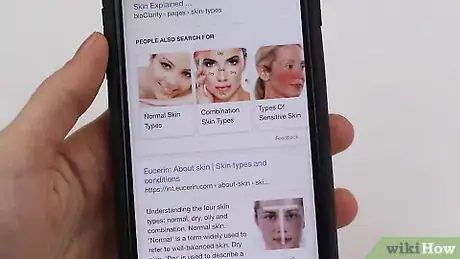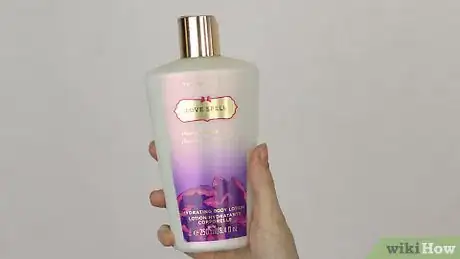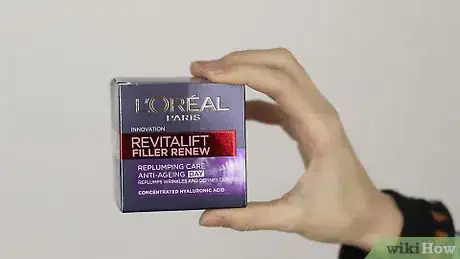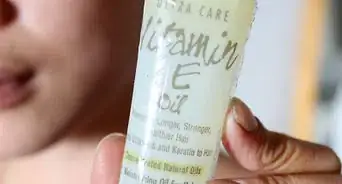This article was co-authored by Erica Coates. Erica Coates is a Professional Makeup Artist and the Owner of Erica Nicole Beauty based in the Washington D.C. metro area. With more than 14 years of experience, she specializes in creating and personalizing makeup looks and skin prep for makeup. Erica received her cosmetology training from the Bennett Career Institute.
There are 9 references cited in this article, which can be found at the bottom of the page.
This article has been viewed 286,986 times.
Most people know that applying lotion helps to moisturize the skin, but many don’t realize that it has other benefits as well. Regularly putting lotion on can help minimize the look of wrinkles, sooth stressed skin and acne, and protect your skin from the elements. To get the maximum benefits from your lotion, there are certain tricks and methods for applying lotion that should be followed. These tricks can help you put lotion on your face, your body, and special areas that need more attention.
Steps
Putting Lotion on Your Face
-
1Figure out what type of face skin you have. Lotions are formulated for the specific needs of different kinds of skin, so the first step is determining the type of skin your face has so you can buy the best product. If you have face lotion already, check the label to make sure it is the right product for what your skin is like now. Skin changes all the time due to things like weather and aging, so be sure you keep in mind what your skin is like currently. The different skin types are:[1]
- Normal skin is neither dry nor oily and is not prone to blemishes or skin sensitivity or irritation.
- Oily skin often looks shiny or greasy due to overactive oil glands in the face. This skin type is prone to blemishes and often has larger-appearing pores.
- Dry skin suffers from a lack of oil and moisture, often appearing flaky with visible lines and reddish patches of skin.
- Sensitive skin is commonly mistaken for dry skin because it also appears red and dry; however, irritation for sensitive skin types is caused by a particular ingredient in a skin care product and not a lack of oil production.
- Combination skin is skin that has patches of oily areas and other areas that are more dry or normal. Most often combination skin is oilier on the forehead, nose, and chin and normal to dry on the rest of the face.
-
2Purchase products with great ingredients for your skin type. Now that you know what type of skin you have on your face, you want to purchase products with ingredients that are best suited for your skin needs. Certain ingredients are scientifically proven to help specific skin needs, so finding products that contain these will help maximize the benefits of the lotion. Some ingredients that are great for each skin type are:[2]
- Normal skin: Look for cream-based moisturizers that contain vitamin C to help manage antioxidant damage. Avoid gels which will be too drying or thicker ointment creams that will be too heavy.
- Oily skin: Use a lightweight, water-based gel formula, which absorb faster than other lotions. Look for ones containing zinc oxide, aloe barbadensis gel, or seaweed extract. Avoid products that contain alcohol and petrolatum.
- Dry skin: Try thicker, cream-based lotions or heavy-duty ointments to help provide a thicker layer of protection from the elements. Look for ingredients like jojoba oil, sunflower seed oil, or rosehip seed oil. Avoid products that contain alcohol, which it too drying for dry skin.
- Sensitive skin: Look for products that contain soothing ingredients like Echinacea, hyaluronic acid, and cucumber extract. Avoid products that contain chemicals, dyes, or perfumes.
- Combination skin: Look for oil-free formulas containing panthenol, zinc oxide, and lycopene. These will help balance out the areas that are oily while providing moisture to areas that are dry.
Advertisement -
3Wash and prep your face for lotion. In order to be sure you are getting the maximum benefits from your lotion, you need to be sure your skin is prepped properly. You should wash your face twice a day, first thing in the morning and before bed, with a cleanser that is also designed for your particular skin type. Using clean hands or a clean washcloth, gently massage the cleanser into your skin with slow, circular motions. Once a week use an exfoliator in place of the cleanser to remove dead skin cells and buildup from the top layers of the skin, which can prevent the absorption of lotion and its active ingredients. Keep in mind:[3]
- Be sure to keep the water temperature lukewarm. Water that is extremely hot can damage the skin, and cold water will close the pores, trapping dirt and bacteria inside the skin.
- Avoid scrubbing too hard as this can cause skin irritation, redness, or breakouts.
- Be sure to rinse your face thoroughly, as any remaining product can clog your pores and cause irritation and blemishes.
-
4Pat your face with a clean, soft cloth until it is damp. Do not dry your face thoroughly. You also don’t want your face to be too wet because your lotion will just slide off when you apply it. You want your face to be damp because the ingredients in face lotions penetrate the skin better when they are dissolved. Applying lotion to damp skin will also create a seal on the top layer of the skin that holds in all of the hydration and nutrients. Be sure to change the towel or cloth regularly to avoid spreading old bacteria onto your newly washed skin.[4]
-
5Apply the appropriate amount of lotion onto your damp skin. Because face lotions are tailored to specific skin types, the consistency of each lotion can vary greatly between lotions. Each product will come with recommendations for how much to apply, but typically thinner lotions require a little more product than thicker ones. Typically the amount of product will range from a pea-sized amount to a quarter-sized dollop. Using the right amount, gently apply the lotion in circular motions using your (clean) fingertips. For extra dry areas, lightly press the lotion into the skin as you apply it.[5] Some additional tips include:
- Avoid applying face lotion to the area around your eyes because it is very delicate and many moisturizers can be too rich. This can cause the eye skin to retain fluid and appear puffy. Only apply eye cream to the eye area.
- It’s ideal if your face lotion has at least SPF 15 in it to help protect your skin throughout the day; however, avoid putting SPF lotion on your face at night because it can clog your pores and cause blemishes.
- You can blend the lotion upward.[6]
- It promotes blood flow to the face and gives the skin a much-needed massage.[7]
- It helps the product to penetrate into the skin for added moisture.[8]
-
6Extend your lotion application to your neck. Many people remember to put lotion on their face after cleansing, but the neck is often forgotten. The skin on your neck is more similar to the skin on your face than it is to the skin on your body, so including it in your face lotion routine is key.[9] Using long, gentle strokes upward from the base of your neck to your jawline, apply face lotion to your neck after your cleanse your face each time. This will help keep the skin on your neck looking hydrated and youthful.
-
7Let your lotion sink in. After applying lotion to your face and neck, wait about 5 minutes before you put on your shirt, apply any makeup, or get into bed. You want to give the lotion time to sink in before doing anything that can disturb the hydrating seal the lotion creates on the upper layers of the skin. Applying makeup too soon can cause the cosmetic products to seep into your pores along with the lotion and clog your pores or appear streaky. If you get dressed too soon or lay your face down on a pillow, the cloth will absorb the lotion instead of the skin, and you won’t get the maximum benefits from the lotion.[10]
Putting Lotion on Your Body
-
1Figure out what skin type your body is. Just like with your face, you want to use a lotion that is designed for your particular skin type. Don’t assume your body has the same skin type as your face either. Sometimes the skin on your body is drier or more acne prone than the skin on your face, and determining the distinct skin type that your body is currently is important.[11]
-
2Purchase body lotion with active ingredients for your skin type. As with face lotions, you want to look for body lotions that include the best ingredients for moisturizing your skin type. This is why it’s especially important to first determine your body skin type, since assuming it is the same as your face could mean applying ingredients that could damage the skin or cause breakouts. Some ingredients that are great for each skin type are:[12]
- Normal skin: Look for thicker lotions or moisturizing creams that include ingredients like vitamin C to help manage antioxidant damage and vitamin E to satiate thirsty skin. Licorice as an ingredient will also help reduce any pigmentation damage.
- Oily skin: Use lightweight, non-greasy formulas, especially ones that are fast absorbing or contain witch hazel, which is a great natural ingredient for reducing excess oil production and body acne by unclogging pores. Avoid thick, greasy products or ones that contain alcohol or petrolatum.
- Dry skin: Look for thick cream-based lotions or healing ointments, especially ones that contain shea butter or coconut oil, two intensely moisturizing ingredients that repair the skin’s moisture barrier. Avoid products that contain alcohol, which will dry out the skin further.
- Sensitive skin: Look for products that contain soothing ingredients like Echinacea to sooth the skin and avocado oil, which contains fatty acids and tons of vitamin B to moisturize the skin and regulate cell function. Avoid products that contain chemicals, dyes, or perfumes.
- Combination skin: Look for oil-free formulas containing panthenol, zinc oxide, and lycopene. Avoid thick creams and water-based gels, which will be too heavy or drying for the combination areas.
-
3Prepare your body for lotion. Though the skin on your body is not as delicate as the skin on your face, you still need to properly prep your skin for lotion in order to get the maximum benefits. You want to shower or bathe every day, washing your body with a cleanser for your body skin type. Use a clean washcloth or loofah to gently scrub your body clean using circular motions. You should also use a body exfoliator in place of the cleanser twice a week to get rid of dead skin cells and product buildup so that your lotion can sink in better. Keep in mind:[13]
- Limit your showers to 5 - 10 minutes to avoid stripping your skin of any moisturizing properties in the cleanser.
- Only use water that is warm-to-hot in temperature. You want the water to be slightly hotter than the water you use to wash your face, but water that is too hot will strip your skin of its natural oils.
- Rinse your body thoroughly so no product remains to clog your pores or cause irritation and blemishes.
- Shaving also exfoliates the skin, so skip exfoliating on days where you shaved your legs, neck, or other areas.
-
4Pat yourself dry with a clean, soft towel until you are damp. Just like with your face, you do not want to towel off completely. You want your skin to remain a little damp to help your lotion absorb fully and lock in moisture. Don’t open the bathroom door yet either so that you keep all of the humid air inside the bathroom. The combination of damp, warm skin and moist air will help activate the ingredients in your lotion and keep your skin looking its best.[14]
-
5Apply lotion immediately. Taking into consideration the consistency of the lotion and the directions on the product, pump or squeeze a suitable amount of lotion into your hands. You don’t want to pump lotion for your entire body into your hands all at once; you want to focus on one area of your body at a time. Rub your hands together to warm up the lotion and then apply it to your body. Gently press the lotion into your skin with slow sweeping motions, focusing your application on areas that are particularly dry, like the knees and elbows.[15]
-
6Let the lotion sink in. Before you exit the steamy bathroom or put on clothes, give the lotion about 5 minutes to sink into your skin. The humidity will keep your pores open, which will allow the lotion to sink in faster and hydrate your skin better. Putting clothes on or wrapping a towel around yourself too soon will wipe away the lotion you just applied, and you will lose all of the moisturizing benefits.
Using Specialty Lotions
-
1Consider your skin needs. The skin on your face and body is easily affected by things like stress, weather, and age, so it’s not uncommon to have a variety of products to address these changing needs. When you shop for lotions, consider what your skin goals are and find a lotion that helps you achieve that goal. In addition to products that treat the standard skin types, you can also find products geared towards:[16]
- Firming or toning
- Self-tanning
- Acne treatment
- Age defying or preventative treatments
- Wrinkle reducing
- Eczema treatment
-
2Use eye cream around the eyes. Many face moisturizers are too rich for the eye area, which is some of the most delicate skin on the body. Treating this skin roughly or with the wrong products can cause wrinkling and sagging of the skin prematurely. Using a lotion specifically designed for the eye area, dot the cream under your eye from the inner to outer corner with your ring finger. The ring finger has the lightest touch, and this dotting motion will reduce the amount of pressure and pull on the skin. Still with the ring finger, finish distributing these dots of lotion by gently patting the lotion into the skin.[17]
-
3Moisturize the hands and cuticles. Because you are constantly using your hands throughout the day, the skin on your hands is exposed to a lot of moisture-wicking abuse. Washing your hands and antibacterial hand sanitizers especially deplete the skin on your hands of natural oils, which can cause dryness, redness, and cracking. To help combat dryness and keep your hands soft and supple, apply lotion to your hands several times throughout the day, especially after washing or sanitizing them. A lotion specifically designed for hands is best because these lotions are often thicker than other options, which helps them stay on to moisturize your hands as much as possible.[18]
-
4Put lotion on your feet before bed. Even though you’re on your feet all day, many people forget to put lotion on their feet as well. Like the hands, your feet take a lot throughout the day and also have delicate cuticles that need to be cared for. Extremely dry feet can crack at the heel and be extremely painful or unsightly. To help combat heel cracks and dry, scaly feet, apply a thick lotion to your feet when you get into bed. This way your feet have all night to absorb the moisturizing nutrients. For best results, you can put on a pair of thick socks after applying lotion to reduce the lotion wiping off on your sheets.
-
5Don’t forget your lips. The skin on your lips is also extremely delicate and prone to dryness. Smiling, talking, and exposure to the wind and sun can really dry out your skin, especially your lips. Many people only notice that their lips are dry once they are already peeling, so try to be proactive in your treatment of this delicate area and apply lip balm before your lips are dried out. Try to find a lip balm that includes natural oils like coconut oil or argan oil for maximum suppleness.[19]
Community Q&A
-
QuestionWhat can a large person that cannot bend over use to put lotion on their feet?
 Community AnswerI use a large wooden spoon for back applications. You could use one of these on your feet if you sit down and place one leg over the other.
Community AnswerI use a large wooden spoon for back applications. You could use one of these on your feet if you sit down and place one leg over the other. -
QuestionCan I put body lotion on my face?
 PurpleOreoCommunity AnswerTechnically, yes. It's better to get face lotion though, as it is made for a different sort of skin.
PurpleOreoCommunity AnswerTechnically, yes. It's better to get face lotion though, as it is made for a different sort of skin. -
QuestionCan you put avocados on your skin?
 Tansy_200Community AnswerAn avocado face mask will soften your skin. Mash half a ripe avocado and mix in a spoonful of honey. Apply it to your freshly cleansed skin and let it sit for twenty or thirty minutes. Rinse off the mask and see beautiful results!
Tansy_200Community AnswerAn avocado face mask will soften your skin. Mash half a ripe avocado and mix in a spoonful of honey. Apply it to your freshly cleansed skin and let it sit for twenty or thirty minutes. Rinse off the mask and see beautiful results!
Warnings
- While applying lotion anywhere on your body, if you get a rash or your skin feels irritated, itchy, or hot, discontinue use immediately. Also take a look at the ingredients in the product so you can start to determine which ingredients you are allergic or very sensitive to.[20]⧼thumbs_response⧽
References
- ↑ http://www.vivawoman.net/2007/12/tips-to-optimize-your-facial-moisturizer/
- ↑ http://www.elle.com/beauty/makeup-skin-care/tips/g8510/best-winter-moisturizers-per-skin-type/
- ↑ http://www.smartskincare.com/bestpractices/howtoapply.html
- ↑ http://www.vivawoman.net/2007/12/tips-to-optimize-your-facial-moisturizer/
- ↑ http://www.vivawoman.net/2007/12/tips-to-optimize-your-facial-moisturizer/
- ↑ Erica Coates. Professional Makeup Artist. Expert Interview. 8 April 2022.
- ↑ Erica Coates. Professional Makeup Artist. Expert Interview. 8 April 2022.
- ↑ Erica Coates. Professional Makeup Artist. Expert Interview. 8 April 2022.
- ↑ http://www.vivawoman.net/2007/12/tips-to-optimize-your-facial-moisturizer/
- ↑ http://www.vivawoman.net/2007/12/tips-to-optimize-your-facial-moisturizer/
- ↑ http://www.vivawoman.net/2008/08/when-should-you-apply-your-body-lotion/
- ↑ http://www.elle.com/beauty/makeup-skin-care/tips/g8510/best-winter-moisturizers-per-skin-type/
- ↑ http://www.smartskincare.com/bestpractices/howtoapply.html
- ↑ http://www.vivawoman.net/2008/08/when-should-you-apply-your-body-lotion/
- ↑ http://www.vivawoman.net/2008/08/when-should-you-apply-your-body-lotion/
- ↑ http://www.mayoclinic.org/diseases-conditions/dry-skin/in-depth/moisturizers/art-20044232?pg=1
- ↑ http://nymag.com/thecut/2014/08/how-to-correctly-apply-eye-cream.html
- ↑ http://dailymakeover.com/youre-doing-it-wrong-moisturizer/
- ↑ http://www.totalbeauty.com/content/gallery/best-worst-lip-balms
- ↑ http://www.mayoclinic.org/diseases-conditions/dry-skin/in-depth/moisturizers/art-20044232?pg=1
About This Article
Before you put lotion on your face, wash it with a gentle cleanser and pat away excess moisture with a soft, clean towel. Dot a small amount of the lotion onto your forehead, cheeks, and jawline, then gently smooth the lotion into your skin with your fingertips. For thinner lotion, use a pea-sized amount, or up to a quarter-sized amount for thicker lotions. When you’re choosing your lotion, look for one that is formulated for your skin type, whether it’s normal, oily, dry, or sensitive. Keep reading to learn how to apply lotion to your body!





































































